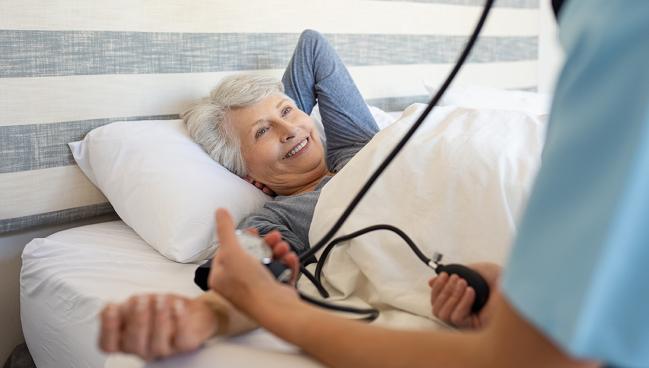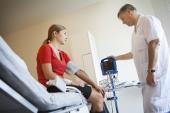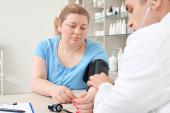High BP While Lying Down Signals Future CVD Risk
It’s not yet time to abandon seated BP measurements, but taking a look at supine readings may provide enhanced risk assessments.

Patients who have hypertension while lying down, even if their blood pressure is normal while sitting up, have greater CVD and mortality risks in the decades to come, according to an analysis of the Atherosclerosis Risk in Communities (ARIC) study.
Through more than 25 years of follow-up, supine hypertension was associated with greater risks of fatal and nonfatal coronary heart disease, heart failure, stroke, and all-cause death, lead author Duc Giao, MD (Harvard Medical School, Boston, MA), and colleagues report in a study published online Wednesday in JAMA Cardiology.
The results didn’t differ based on whether patients were taking antihypertensive medications or whether they also had seated hypertension. Although risks of adverse outcomes were greatest in patients with both seated and supine hypertension, those with high supine BP alone carried greater hazards compared with those with elevations only when seated.
“Our conclusion was that not only is supine blood pressure an important risk factor for cardiovascular disease, but also it’s possible we could be missing a high-risk state by simply focusing on the seated position,” senior author Stephen Juraschek, MD, PhD (Beth Israel Deaconess Medical Center and Harvard Medical School), told TCTMD. “There might be more information to be gathered when we lie people flat and measure their blood pressure in the lying position.”
That could be a challenge in everyday clinical practice, where physicians often have only 15 minutes to see each patient and where BP is typically measured with patients sitting up, according to Keith Ferdinand, MD (Tulane University School of Medicine, New Orleans, LA), who was not involved in the study.
“Hypertension is the most powerful and prevalent of the cardiovascular risk factors, and the extent to which we’re able to determine how best to measure blood pressure is an ongoing debate,” he commented to TCTMD. “This study is provocative in that it suggests that the conventional seated blood pressure that’s done in clinic and office settings may not be adequate for some patients who have supine blood pressure elevations, even with seated blood pressures less than 130 over 80 [mm Hg].”
Supine vs Seated BP Measurements
Prior research has shown that nocturnal hypertension is associated with greater risks of CVD and death, but whether having high BP while lying down is a risk factor for CVD independent of seated hypertension remains unclear.
To explore the issue, the investigators turned to the ARIC study, which examined CV risk factors in adults who were ages 45 to 64 at baseline and were followed for decades. The current analysis included 11,369 participants (mean age 53.9 years; 55.7% women) who were free of known CVD when they started the study and who had both supine and seated BP measurements available.
Both supine and seated hypertension were defined using a BP threshold of at least 130/80 mm Hg. Supine hypertension was found in 16.4% of those without hypertension measured while they were sitting up and in 73.5% of those who had high seated BP.
Hypertension is the most powerful and prevalent of the cardiovascular risk factors, and the extent to which we’re able to determine how best to measure blood pressure is an ongoing debate. Keith Ferdinand
Over long-term follow-up, supine hypertension was associated with incident coronary heart disease (HR 1.60; 95% CI 1.45-1.76), heart failure (HR 1.83; 95% CI 1.68-2.01), stroke (HR 1.86; 95% CI 1.63-2.13), fatal coronary heart disease (HR 2.18; 95% CI 1.84-2.59), and all-cause mortality (HR 1.43; 95% CI 1.35-1.52), irrespective of seated hypertension.
Having hypertension only while lying down conferred a similar degree of risk as having hypertension in both the supine and seated positions, but a significantly greater level of risk compared with seated hypertension alone (for each outcome except for fatal coronary heart disease).
“We think that this study is really important because it highlights that this could be an . . . occult form of hypertension that can be detected by patients or clinicians very readily,” Juraschek said, noting that even if it could be a challenge to measure supine BP in the clinic, patients could do it at home with a validated device.
Changes to Practice?
Though provocative and likely to stimulate more interest in studying the effects of supine BP, these data are not enough to change current guidelines around how to measure BP in the usual clinic setting, Ferdinand said. He added that another alternative to seated BP measurements in the clinic—24-hour ambulatory BP blood pressure monitoring (ABPM)—is often not reimbursed and can be tolerated poorly by patients.
Short of switching to supine measurements, “the interim step would be to ensure, first of all, that seated blood pressure is done appropriately,” Ferdinand said. “Secondly, in patients who are middle-aged, similar to this population and older, perhaps consider supine blood pressure if there is a desire to have a further determination of risk.”
It’s possible we could be missing a high-risk state by simply focusing on the seated position. Stephen Juraschek
Indeed, Juraschek said, measuring supine BP may aid decisions about whether antihypertensive treatment is warranted in patients whose seated BP is close the hypertension threshold. He cautioned, however, that additional research is needed to determine whether initiating treatment for supine hypertension, even if patients have normal seated BP, can prevent adverse outcomes.
Juraschek is not advocating for drastic changes to how BP is measured right now.
“Decades of hypertension trials have focused on the seated blood pressure position and I’m not saying we should abandon that. That’s where [the] weight of the evidence is,” he said. But measuring supine hypertension, he added, may provide a more accessible way to identify high-risk patients who have nocturnal hypertension without dealing with the challenges of ABPM.
Many questions remain, Juraschek said, including around the link between supine BP and risks of dementia or cognitive decline; the mechanisms underlying its relationship with long-term cardiovascular outcomes; and whether low BP while patients are lying down influences outcomes.
Todd Neale is the Associate News Editor for TCTMD and a Senior Medical Journalist. He got his start in journalism at …
Read Full BioSources
Giao DM, Col H, Kwapong FL, et al. Supine blood pressure and risk of cardiovascular disease and mortality. JAMA Cardiol. 2025;Epub ahead of print.
Disclosures
- ARIC has been funded in whole or in part with federal funds from the National Heart, Lung, and Blood Institute (NHLBI).
- Juraschek reports support from an NHLBI grant.
- Giao reports no relevant conflicts of interest.





Comments